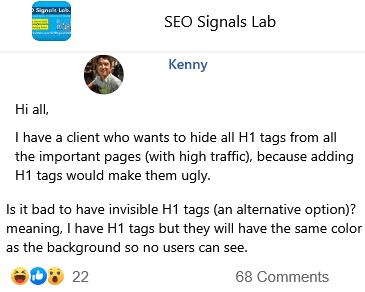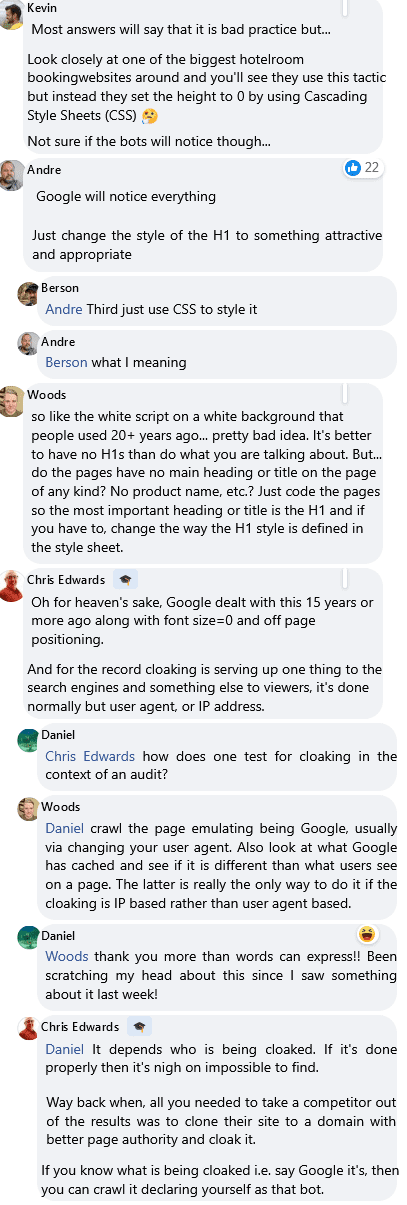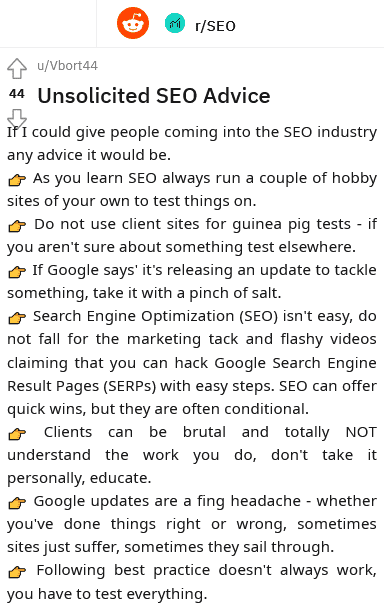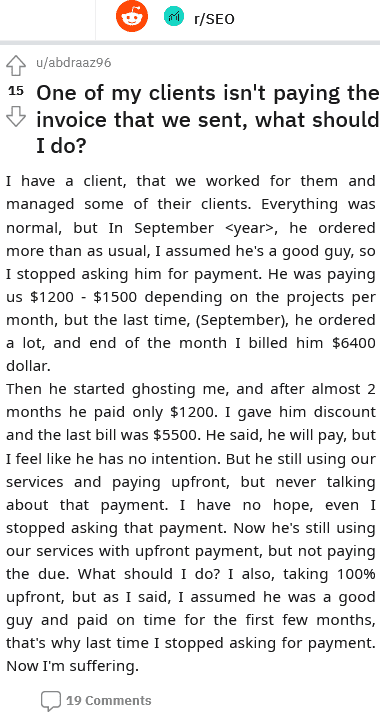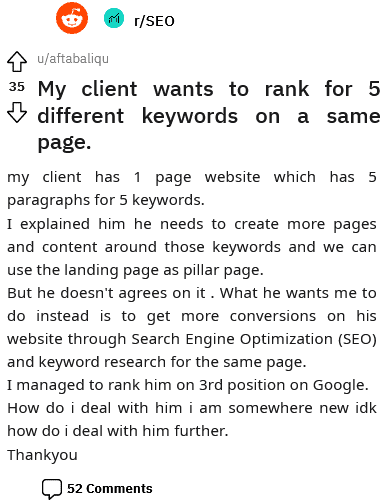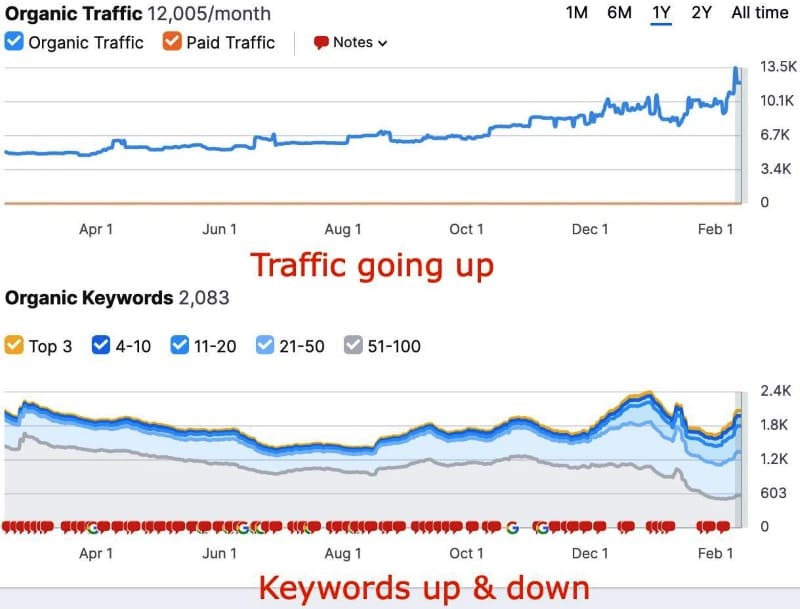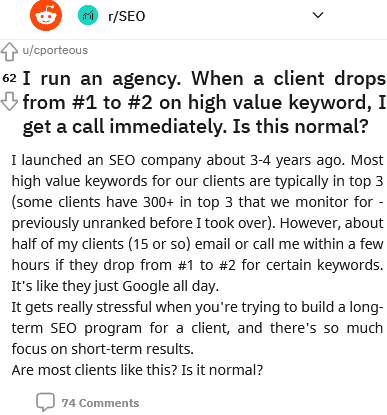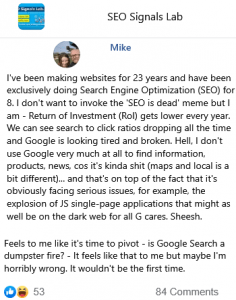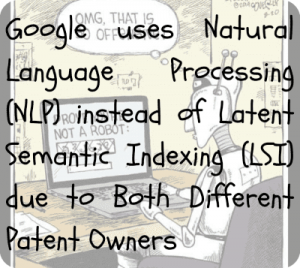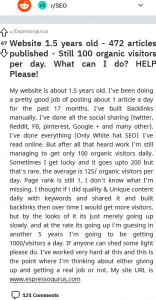Hi all,
I have a client who wants to hide all H1 tags from all the important pages (with high traffic), because adding H1 tags would make them ugly.
Is it bad to have invisible H1 tags (an alternative option)? meaning, I have H1 tags but they will have the same color as the background so no users can see.
10 🤭8 👍🏽4 🤯2268 💬🗨
📰👈
Most answers will say that it is bad practice but…
Look closely at one of the biggest hotelroom bookingwebsites around and you'll see they use this tactic but instead they set the height to 0 by using Cascading Style Sheets (CSS)🤔
Not sure if the bots will notice though…
Andre
Google will notice everything
Just change the style of the H1 to something attractive and appropriate
👍🏽22
Second
Berson » Andre
Third just use CSS to style it
Andre » Berson
What I meaning
Woods
so like the white script on a white background that people used 20+ years ago… pretty bad idea. It's better to have no H1s than do what you are talking about. But… do the pages have no main heading or title on the page of any kind? No product name, etc.? Just code the pages so the most important heading or title is the H1 and if you have to, change the way the H1 style is defined in the style sheet.
Chris Edwards 🎓
Oh for heaven's sake, Google dealt with this 15 years or more ago along with font size=0 and off page positioning.
And for the record cloaking is serving up one thing to the search engines and something else to viewers, it's done normally but user agent, or IP address.
How does one test for cloaking in the context of an audit?
Woods » Daniel
Crawl the page emulating being Google, usually via changing your user agent. Also look at what Google has cached and see if it is different than what users see on a page. The latter is really the only way to do it if the cloaking is IP based rather than user agent based.
Daniel » Woods
Thank you more than words can express!! Been scratching my head about this since I saw something about it last week!
🤭
Chris Edwards 🎓 » Daniel
It depends who is being cloaked. If it's done properly then it's nigh on impossible to find.
Way back when, all you needed to take a competitor out of the results was to clone their site to a domain with better page authority and cloak it.
If you know what is being cloaked i.e. say Google it's, then you can crawl it declaring yourself as that bot.
📰👈
Ammon Johns 🎓
This is why I say if someone cannot code, they cannot do Search Engine Optimization (SEO). H1s can look like anything you want using Cascading Style Sheets (CSS) – they can look like regular body text, they can look like links, they can be any size or boldness, italic, or whatever. Been that way since CSS was first introduced more than 20 years ago.
BUT, if a H1 is changed to look like regular text, it will tend to be treated like regular text, meaning no advantage to having used H1 in the first place, other than for those with user agents built for the visually impaired, which read out all the cues a blind user would not otherwise know.
If you don't know about CSS, even to its most basic capabilities, you should stick to just writing SEO friendly copy, or doing link-building outreach, in association with an actual SEO. Because I guarantee you there will be a lot, lot more things you don't know that could seriously harm a client, and potentially ruin your business reputation, or even result in a lawsuit.
💟13
Great, there are lots of successful SEO users don't know how to code, even I'm working with a ton of clients, I know very very basic, I agree, at least I have to understand what should I do. If know I can easily take the help from our other team members who can code.
Ammon Johns 🎓
Just to add a little further background for those it may interest, white text on a white background was automatically detected and penalized by search engines before Google existed. Altavista was very hot on it.
So instead those who wanted to be sneaky but in a very amateurish way would use a background image of a colour they could hide the text against because back then, search engines were limited to big old servers and had very limited processing cycles – they didn't do much image analysis, even for colour. That would NOT work today where Google processes images quite extensively.
The real black hats used cloaking instead, of course, where the page served to a search engine spider IP address was different to what would be served to users. There were entire companies and forums that existed purely to keep up with all the latest spider IP addresses, often using bot-traps to detect them – links a user wouldn't see, but a spider would, and thus would give away its IP by crawling.
That doesn't really work today either. Far too many search engines have their own browsers (explorer/edge/chrome) which ping back data on usage to the search engines. This data isn't used for ranking, but it tells them instantly if users are getting a different sized file to that the search engines get, and detects what used to be called "poor man's cloaking" which was using redirects instead of IP based serving.
This is all stuff from the 1990s. It's been done, and even then was much more advanced than just white text on a white background. There's a reason we knew about this way back and stopped doing it – it doesn't work, and it can get your site seriously penalized, even completely banned.
The good ole days yee ha
🤭2
Ammon Johns 🎓 » Chris Edwards
Well, ole days, I'll agree with. 😃
Cloaking was a pain as much for those of us who actually had rankings as for the search engines. Back then, on-page SEO was all there was. Wanted to rank for a tough keyword, then all you'd do is save a copy of the top ranked page, and use cloaking to serve that page to the spiders, knowing it was already going to rank top.
I worked a lot in the adult industry, dating sites, etc, and several of my clients had non-stop problems with this, and more obvious forms of just copying our ranking pages and changing the brand and trademarks.
That's why I invented what I called 'Reverse Cloaking'. This meant serving a clean, well optimised page to the engines, but serving actual humans with a version that included white text on white, the telltale tracking gif from WebPosition Gold that Altavista would detect and ban, etc, etc. Then I emailed Altavista and told them what I was doing.
I reckon they found it as funny as I did. But it worked. No more issues of people copying our pages in the SERPs 😃
This is yet another reason why you should NEVER assume that the spammy stuff you see when checking out a competitor is why they are ranking. Some of them are sneaky gits like me. 😉
Chris Edwards 🎓 » Ammon Johns
Yeh the days of sitting up all night tweaking a page multiple times submitting it, checking tweaking and then be at number 1 and it's time for bed.
WPG, I'd forgotten all about that piece of kit.
🤭2
Ammon Johns 🎓 » Chris Edwards
Their forum was the first one I became really well-known in.
Ajmal » Ammon Johns
A quick question, I have around 800 images of products from Amazon and those were uploaded to my website and used from Gallery. Now i want to fetch directly from Amazon to be safe from any violation.
So the question is if i will delete those 800 images, will it harm my website? Need to 301 images URL or ignore? Please lmk!
Thank you.
Ammon Johns 🎓 » Ajmal
Removing the images shouldn't harm the website as a stand-alone factor, but you may be getting pretty close to 'hotlinking' the images, which is something to avoid. Given that Amazon themselves don't produce the images, they come straight from those who add their products to the Amazon platform, there's probably no great advantage to deleting them, or worrying about it. Often the same manufacturer or seller will use the exact same images they uploaded to Amazon in other places, including their own websites, other shopping platforms, etc.
Ajmal » Ammon Johns
Last day someone were discussing that using Amazon listing images is against their terms of services. That's why i thought to remove those…
Ammon Johns 🎓 » Ajmal
Hotlinking them certainly is. But since the vast majority of product images uploaded to Amazon were taken and uploaded by the lister, often the manufacturers own imagery, that same listing person may often have used those images elsewhere already, giving Amazon no claim at all to them.
💟
Ajmal » Ammon Johns
Got it. Thank you so much 😊
John
I read as far as "I have a client who wants"
💟🤭7
💯
📰👈
John » Kenny
Jokes aside, you cant let client dictate the way in which you operate – especially when it involves strategy and implementation. You've got to learn to push back and say no. If they're more interested in having a pretty website than they are generating additional business and increasing revenue, then you might be best to let them go.
Anytime you let the client take over, you've immediately lost control. When that happens you begin changing your processes and that often means the work you're performing either isn't ideal, not recommended or just plain wrong.
This of course means results take longer or they simply don't happen at all.
Ultimately you'll find yourself on a call having an uncomfortable conversation with a client who's demanding answers, results now, or their money back.
Learn to say no.
There's no point working with clients who buy a dog then stand in the front yard barking themselves.
Khoo
I would convince them not to hide the H1s and leave it as is.
And explain why to the client since it seems important to them.
I might not even CSS style the H1s, because there's always more important SEO or Conversion Rate Optimization (CRO) work to do for the client.
Oh I get your doing WordPress and cant code.
Pay a dev to style them h1s.
For a developer. The h1s would already be styled and be apart of the website. Never leave h1s ugly.
Khoo
Thank you, I understand where you are coming from.
My approach is more on managing priorities and the client.
Also, I can do WordPress and code 😊
Andrew » Khoo
I was referring to the op
Ferdinand
That's so easy to resolve with a few simple lines of CSS code. Just ask a WordPress programmer. If you are low on money Fivr might do the job.
You just need to create a CSS class to style the 'ugly' h1 tags in the way you want.
For example, you can style h1 tags to look like h2 tags. Apply the newly created class to the 'ugly' h1 tags and they will look fine.
The users won't notice but Google will read the tags correctly.
PS: In many SEO audits I find h1 to h5 tags all over the place. The reason: the tags are not being used to create a structured hierarchy, but just for the look of it. Really bad practice.
H1 {display: none!important;}
Done but I'm not so sure Google or Bing will like it…
O'Brien
Ugly as in too large? edit the CSS file and reduce the H1 font size and font family.
📰👈
Does Font Size of the H1 Header-1 Affect Search Engine Optimization SEO?
